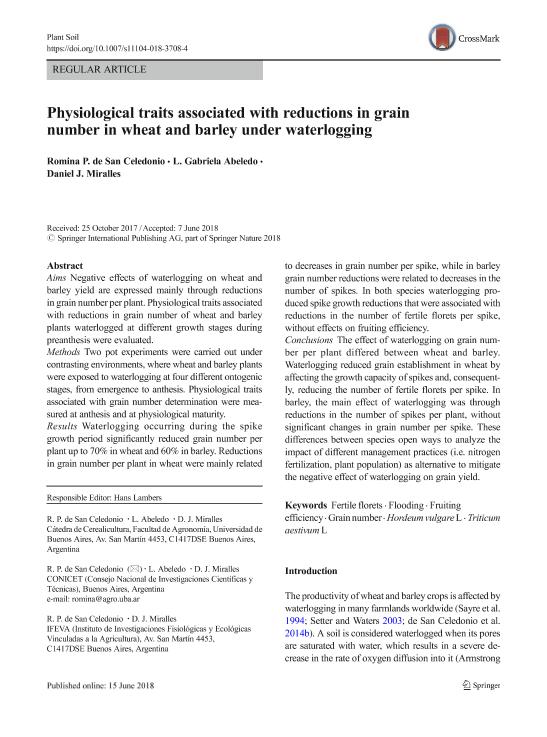Mostrar el registro sencillo del ítem
dc.contributor.author
de San Celedonio, Romina Paola

dc.contributor.author
Abeledo, Leonor Gabriela

dc.contributor.author
Miralles, Daniel Julio

dc.date.available
2020-01-10T16:10:17Z
dc.date.issued
2018-08
dc.identifier.citation
de San Celedonio, Romina Paola; Abeledo, Leonor Gabriela; Miralles, Daniel Julio; Physiological traits associated with reductions in grain number in wheat and barley under waterlogging; Springer; Plant and Soil; 429; 1-2; 8-2018; 469-481
dc.identifier.issn
0032-079X
dc.identifier.uri
http://hdl.handle.net/11336/94300
dc.description.abstract
Aims Negative effects of waterlogging on wheat and barley yield are expressed mainly through reductions in grain number per plant. Physiological traits associated with reductions in grain number of wheat and barley plants waterlogged at different growth stages during preanthesis were evaluated. Methods Two pot experiments were carried out under contrasting environments, where wheat and barley plants were exposed to waterlogging at four different ontogenic stages, from emergence to anthesis. Physiological traits associated with grain number determination were measured at anthesis and at physiological maturity. Results Waterlogging occurring during the spike growth period significantly reduced grain number per plant up to 70% in wheat and 60% in barley. Reductions in grain number per plant in wheat were mainly related to decreases in grain number per spike, while in barley grain number reductions were related to decreases in the number of spikes. In both species waterlogging produced spike growth reductions that were associated with reductions in the number of fertile florets per spike, without effects on fruiting efficiency. Conclusions The effect of waterlogging on grain number per plant differed between wheat and barley. Waterlogging reduced grain establishment in wheat by affecting the growth capacity of spikes and, consequently, reducing the number of fertile florets per spike. In barley, the main effect of waterlogging was through reductions in the number of spikes per plant, without significant changes in grain number per spike. These differences between species open ways to analyze the impact of different management practices (i.e. nitrogen fertilization, plant population) as alternative to mitigate the negative effect of waterlogging on grain yield.
dc.format
application/pdf
dc.language.iso
eng
dc.publisher
Springer

dc.rights
info:eu-repo/semantics/openAccess
dc.rights.uri
https://creativecommons.org/licenses/by-nc-sa/2.5/ar/
dc.subject
FERTILE FLORETS
dc.subject
FLOODING
dc.subject
FRUITING EFFICIENCY
dc.subject
GRAIN NUMBER
dc.subject
HORDEUM VULGARE L
dc.subject
TRITICUM AESTIVUM L
dc.subject.classification
Agricultura

dc.subject.classification
Agricultura, Silvicultura y Pesca

dc.subject.classification
CIENCIAS AGRÍCOLAS

dc.subject.classification
Agricultura

dc.subject.classification
Agricultura, Silvicultura y Pesca

dc.subject.classification
CIENCIAS AGRÍCOLAS

dc.title
Physiological traits associated with reductions in grain number in wheat and barley under waterlogging
dc.type
info:eu-repo/semantics/article
dc.type
info:ar-repo/semantics/artículo
dc.type
info:eu-repo/semantics/publishedVersion
dc.date.updated
2019-10-23T21:10:52Z
dc.journal.volume
429
dc.journal.number
1-2
dc.journal.pagination
469-481
dc.journal.pais
Alemania

dc.description.fil
Fil: de San Celedonio, Romina Paola. Universidad de Buenos Aires. Facultad de Agronomía. Departamento de Producción Vegetal. Cátedra de Cerealicultura; Argentina. Consejo Nacional de Investigaciones Científicas y Técnicas. Oficina de Coordinación Administrativa Parque Centenario. Instituto de Investigaciones Fisiológicas y Ecológicas Vinculadas a la Agricultura. Universidad de Buenos Aires. Facultad de Agronomía. Instituto de Investigaciones Fisiológicas y Ecológicas Vinculadas a la Agricultura; Argentina
dc.description.fil
Fil: Abeledo, Leonor Gabriela. Consejo Nacional de Investigaciones Científicas y Técnicas; Argentina. Universidad de Buenos Aires. Facultad de Agronomía. Departamento de Producción Vegetal. Cátedra de Cerealicultura; Argentina
dc.description.fil
Fil: Miralles, Daniel Julio. Universidad de Buenos Aires. Facultad de Agronomía. Departamento de Producción Vegetal. Cátedra de Cerealicultura; Argentina. Consejo Nacional de Investigaciones Científicas y Técnicas. Oficina de Coordinación Administrativa Parque Centenario. Instituto de Investigaciones Fisiológicas y Ecológicas Vinculadas a la Agricultura. Universidad de Buenos Aires. Facultad de Agronomía. Instituto de Investigaciones Fisiológicas y Ecológicas Vinculadas a la Agricultura; Argentina
dc.journal.title
Plant and Soil

dc.relation.alternativeid
info:eu-repo/semantics/altIdentifier/url/http://link.springer.com/10.1007/s11104-018-3708-4
dc.relation.alternativeid
info:eu-repo/semantics/altIdentifier/doi/http://dx.doi.org/10.1007/s11104-018-3708-4
Archivos asociados
